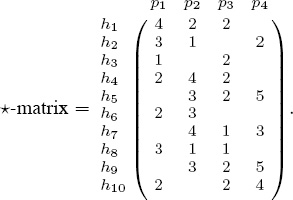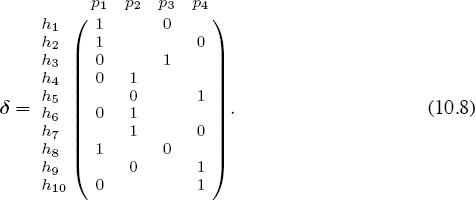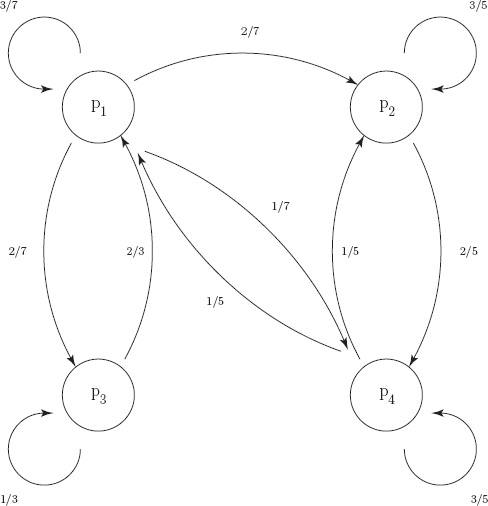Chapter Ten
User Preference Ratings
The “spread rating” ideas that were introduced in (9.4) on page 120 transcend sports ratings and rankings. A major issue that has arisen in recent years in the wake of online commerce is that of rating and ranking items by user preference. While they may not have been the first to employ user rating and ranking systems for product recommendation, companies such as Amazon.com and Netflix have developed highly refined (and proprietary) techniques for online marketing based on product recommendation systems. It would require another book to delve into all of the details surrounding these technologies, but we can nevertheless hint at how some of the ideas surrounding the spread ratings might apply.
Suppose that we are an e-tailer selling products on the World Wide Web, and suppose that we collect user preference scores in a manner similar to Amazon.com—i.e., each product is scored by a user on a five-star scale.

The goal is to turn these user scores into a rating system that we can use to suggest highly rated products similar to the ones that the shopper is currently viewing or buying. It is not possible to effectively leaf through a large inventory catalog with a Web browser, especially if one is not sure of what they want or what’s in the catalog, so a large portion of the success of online retailing depends on the degree to which a company can be effective in recommending products that customers can trust. It’s simple,
Build a better product rating system ![]() Generate greater trust
Generate greater trust ![]() Make more sales!
Make more sales!
Building a simple product rating system from user recommendations is easily accomplished just by reinterpreting the skew-symmetric score-differential matrix K on page 118. For example, suppose that
![]()
is the set of products in our inventory, and let ![]() i and
i and ![]() j respectively denote the set of all users that have evaluated products pi and pj, so
j respectively denote the set of all users that have evaluated products pi and pj, so ![]() i ∩
i ∩ ![]() j is the set of all users that have evaluated both of them. When comparing pi and pj (i ≠ j), let nij = #(
j is the set of all users that have evaluated both of them. When comparing pi and pj (i ≠ j), let nij = #(![]() i ∩
i ∩ ![]() j) be the number of users that evaluate both of them, and define the “score” that pi makes against pj, to be the average star rating
j) be the number of users that evaluate both of them, and define the “score” that pi makes against pj, to be the average star rating

Define, the “score difference” between products pi and pj to be

and, just as in (9.4), let
![]()
be the skew-symmetric matrix of score differences. The development on page 120 produces the following conclusion regarding the best ratings that can be produced by averaging a given set of “star scores.”
The Best Star Rated Products
For a given set of star scores, the best (in the sense described on page 118) set of ratings that can be derived by averaging star scores is given by the centroid
r = Ke/n,
where K is the skew-symmetric matrix of average star-score differences given in (10.3).
For example, suppose ten users ![]() = {h1, h2, . . . , h10} have evaluated four products P = {p1, p2, p3, p4} using a five-star scale, and suppose that their individual evaluations (number of stars) are accumulated in the matrix
= {h1, h2, . . . , h10} have evaluated four products P = {p1, p2, p3, p4} using a five-star scale, and suppose that their individual evaluations (number of stars) are accumulated in the matrix

Notice that there are several missing entries in this matrix because not all users evaluate all products. In fact, the desire to extrapolate values for missing entries was the motivation behind the famous Netflix contest [56]. When the scores Sij defined by (10.1) are arranged in a matrix, the resulting score matrix is

The skew-symmetric matrix K of score differences defined by (10.3) is

Therefore, the star ratings derived from user evaluations is

so the products rank (from highest to lowest) in the order {p4, p1, p2, p3}.
Direct Comparisons
Using the average star scores (10.2) to define the “score difference” between two products is a natural approach to adopt, but there are countless other ways to define score differences. For example, a retailer might be more interested in making direct product comparisons by setting Sij to be the proportion of people in Ui ∩ Uj who prefer pi over pj. Such comparisons could be determined from user star scores if they were available, but direct comparisons are often obtained from old-fashion market surveys or point-of-sales data. To be precise, let

and define

If K is reinterpreted to be the skew-symmetric matrix of direct-comparison score differences
![]()
then the results in (9.4) on page 120 produce the following statement concerning the best “direct comparison” product ratings.
The Best Direct-Comparison Ratings
The best (in the sense described on page 118) product ratings that can be derived from direct comparisons is the centroid
![]()
where K is the skew-symmetric matrix of direct-comparison score differences given by (10.6).
For example, suppose ten users U = {h1, h2, . . . , h10} are involved in making direct comparisons of four products P = {p1, p2, p3, p4}, and suppose that the binary comparison results described in (10.4) are accumulated in the matrix

This means, for instance, that user h1 compares products p1 with p3 and selects p1, while user h5 compares p2 with p4 and chooses p4, etc. (The users need not be distinct—e.g., user h1 could be the same as user h5.) When the scores Sij defined by (10.5) are arranged in a matrix, the resulting score matrix is

Consequently, the skew-symmetric matrix K of direct-comparison score differences is

and thus the direct-comparison product ratings derived from (10.7) is

In other words, the products rank (from highest to lowest) in the order {p4, p2, p3, p1}.
Direct Comparisons, Preference Graphs, and Markov Chains
Another way to derive ratings based on direct comparisons between products is to build a preference graph. This is a directed graph with weighted edges in which the nodes of the graph represent the products in P = {p1, p2, . . . , pn}, and a weighted edge from pi to pj represents, in some sense, the probability of favoring product pj given that a person is currently “using” product pi. While there are countless many ways to design user surveys to determine these probabilities, they can be constructed on the basis of direct comparisons such as those in the previous example (10.8).
1. For each product pi, list all users Hi = {hi1, hi2, . . . , {hi1, hi2, . . . , hik,} who evaluated pi.
2. If there is a user in Hi that prefers product pj, then draw an edge from pi to pj.
3. The weight (or probability) qij associated with the edge from pi to pj is the proportion of users in Hi that prefer product pj. In other words, if nij is the number of users in Hi that prefer product pj. then
![]()
This preference graph defines a Markov chain [54, page 687], and rating the products in P can be accomplished by analyzing a random walk on this graph to determine the proportion of time spent at each node (or product). This is in essence the same procedure used in Chapter 6 on page 67. The idea is to mathematically watch a “random shopper” move forever from one product to another in the preference graph—if the shopper is currently at product pi, then the shopper moves to product pj with probability qij. The rating value ri for product pi is the proportion of time that the random shopper spends at that product.
If there is sufficient connectivity in the preference graph, then the proportion of time that a random shopper spends at product pi (i.e., the rating value ri) is the ith component of the vector r that satisfies the equation.

This vector r that defines our ratings is also called the stationary probability vector for the Markov chain (or random walk). This approach to rating and ranking is in fact the foundation of Google’s PageRank—see [49].
For example, consider the direct comparisons given in the matrix δ in (10.8) that are produced when ten users {h1, h2, . . . , h10} evaluated four products {p1, p2, p3, p4}. From the data in δ we see that
p1 is evaluated by users {h1, h2, h3, h4, h6, h8, h10} = H1,
p2 is evaluated by users {h4, h5, h6, h7, h9} = H2,
p3 is evaluated by users {h1, h3, h8} = H3,
p4 is evaluated by users {h2, h5, h7, h9, h10} = H4.
Furthermore, we can also see from δ that of the seven users who evaluated p1, three of them preferred p1; two of them preferred p2; two of them preferred p3; and one of them preferred p4. Consequently, there are four edges (paths) leaving node p1 in the preference graph shown in Figure 10.1 with respective weights q11 = 3/7; q12 = 2/7; q13 = 2/7; and q14 = 1/7, and thus the first row of Q, shown below in (10.10), is determined. Similarly, the edges (paths) leaving the second node p2 and the entries in the second row of Q are derived by observing that of the five users who evaluated p2, none preferred p1; three preferred p2; none preferred p3; and two preferred p4, so q21 = 0; q22 = 3/5; q23 = 0; and q24 = 2/5.
Figure 10.1 Product preference graph
Use the same reasoning to complete the preference graph and to generate the third and fourth rows of

The Markov rating vector r is obtained by solving the five linear equations defined by
rT (I − Q) = 0 and rTe = 1
for the four unknowns {r1, r2, r3, r4}. The result is

so our four products are ranked (from highest to lowest) as {{p4, p2}, p1, p3}, where p4and p2 tied.
Centroids vs. Markov Chains
There are several problems with the Markov chain (or random walk) approach to rating. First, when there are a lot of states (or products in this case), there is often insufficient connectivity in the graph to ensure that the solution of rTQ = rT, rT e = 1 (i.e., the ratings vector) is well defined. For such cases artificial information or perturbations must be somehow forced into the graph to overcome this problem, and this artificial information necessarily pollutes the purity of the “real” information—see [49]. Consequently, the resulting ratings and rankings are not true reflections of the actual data. However, this is a compromise that must be swallowed if Markov chains are to be used. On the other hand, using a centroid method requires no special structure in the data, so no artificial information need be introduced to produce ratings. Furthermore, even if the graph can be somehow perturbed or altered to guarantee that a well defined stationary probability vector exists, computing r can be a significant task in comparison to computing centroids, which is relatively trivial.
Conclusion
The centroid rankings (10.9) on page 130 and the Markov ratings (10.11) are both derived from the same direct comparisons data in (10.8). The centroid method ranks the products in the order {p4, p2, p3, p1}, while the Markov method yields the ranking as {{p4, p2}, p1, p3}. It is dangerous to draw conclusions from small artificial examples like these, but you can nevertheless see that the centroid rankings are in the same ball park as the Markov rankings. What is clear from this example is that the centroid rankings are significantly easier to determine, so if a centroid method can provide you with decent information, then they should be the method of choice.

